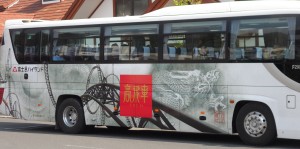July 22, 2012

Super cool looking dragon bus
Having been in Japan for a while, I have used quite a bit of public transportation. Trains, buses, shinkansen (bullet trains) and subways exist virtually ubiquitously throughout Japan. Even small towns often have train stations that can take you wherever you would like to go. With the super-efficient and highly available public transportation system, it is quite easy to get from any given point in Japan to another. And, even though the system is huge and my Japanese is not the best, I still find it pretty easy to get around Japan. Public transportation in Japan is privately owned, but used by almost every citizen, even for daily activities. Unlike in the United States, where almost everybody goes to work, the store, or anywhere else by car, Japanese citizens often use public transit. It is not uncommon for a person in Japan to commute to work an hour away by train daily. This is especially feasible because Japanese public transportation is very punctual and is considered late if it does not arrive by the specified minute.

Passenger train
But, the benefits of Japan’s massive public transportation system goes far beyond convenience: it also is much better for the environment. The widespread use of public transit in Japan causes the country to have much less carbon emissions than if cars were the dominant means of getting around. To compare the impact of different means of transportation, scientists usually calculate the amount of energy per passenger mile (100 p-km) to standardize for comparison. In Japan in 1999, the measured efficiencies were 68 kWh per 100 p-km for cars, 19 kWh per 100 p-km for buses, 6 kWh per 100 p-km for railways, 51 kWh per 100 p-km for air, and 57 kWh per 100 p-km for sea. According to this data in 1999, railways, which are some of the most popular ways to get around in Japan, were over 11 times more efficient than using a car! More recent data puts car and air travel in Japan at 2.0 MJ/pkm, buses at 0.7 MJ/pkm and railways at 0.4 MJ/pkm (when caclulated from primary energy) or 0.2 MJ/pkm (when calculated from electricity kwh). Still, one can see that the efficiency of cars is much less than that of public transportation. The widespread use of public transportation in Japan reduces carbon emission by using less energy, and thus is a better way for eco-friendly travel. One study even estimates that if the U.S. had used public transit as its main means of transportation in 2005, it would have reduced CO2 emissions by 6.9 million metric tons: 3.9 directly saved from cars, and 3.0 saved from reducing traffic congestion.